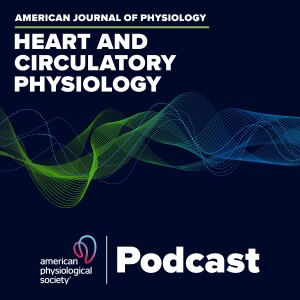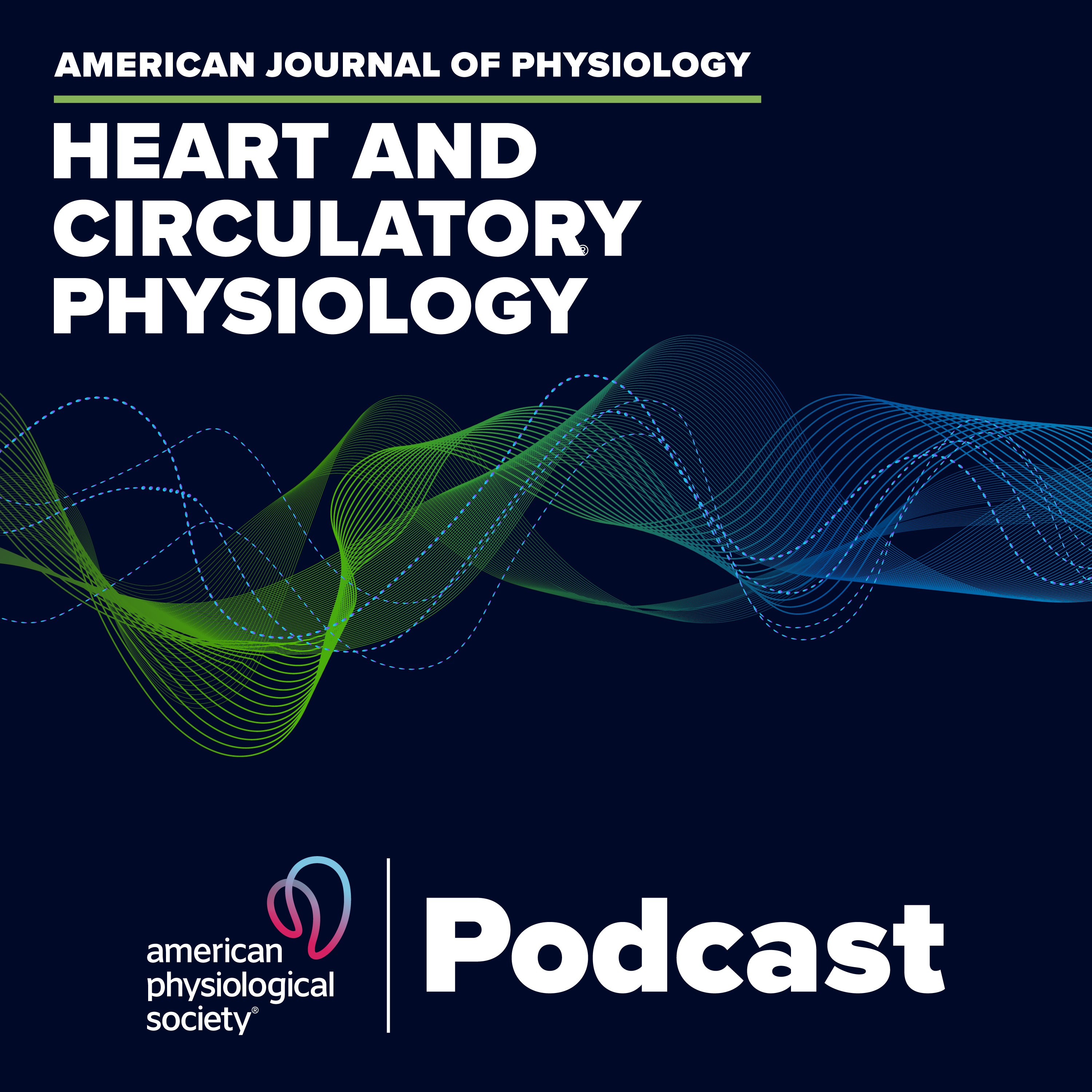Episodes

Friday Oct 23, 2015
Friday Oct 23, 2015
In this Japanese language version of the podcast, Associate Editor Junichi Sadoshima (Rutgers New Jersey Medical School) interviews lead author Yasushi Fujio (Osaka University) and content expert Yasuko Bando (Nagoya University) in Japanese about the innovative work by Enomoto et al, in which Fujio and his collaborators created cardiac-specific conditional STAT3 knockout mice designed to knockout STAT3 only after myocardial infarction. In STAT3 null mice, ROS production increased, which then lead to a cascade of negative effects, first inducing cardiac hypertrophy, then suppressing angiogenesis. Is suppression of superoxide production the primary cardioprotective pathway of STAT3? Listen to learn more.
Daichi Enomoto, Masanori Obana, Akimitsu Miyawaki, Makiko Maeda, Hiroyuki Nakayama, Yasushi Fujio Cardiac-specific ablation of the STAT3 gene in the subacute phase of myocardial infarction exacerbated cardiac remodeling Am J Physiol Heart Circ Physiol, published August 1, 2015, DOI: 10.1152/ajpheart.00730.2014.

Wednesday Sep 23, 2015
VNS Mitigates Neuronal and Myocyte Remodeling Following MI
Wednesday Sep 23, 2015
Wednesday Sep 23, 2015
After more than 40 years of studying the complexities of neural control of myocardial function, what are we learning now about how the intrinsic cardiac nervous system is dominated by intracardiac ganglia that both send and receive information from the heart? Editor in Chief Dr. Irving H. Zucker explores this and more in a new author interview with lead author Jeffrey Ardell (UCLA School of Medicine) and content expert David Mendelowitz (George Washington University) about the fascinating new work by Beaumont et al about vagal nerve stimulation and cardiac neuromodulation. What is the role of these intracardiac ganglia in the remodeling process of myocytes and the cardiac nervous system following myocardial ischemia? Did Ardell and colleagues find that vagal nerve stimulation could restore the central vagal drive and sustain contractile function in the case of chronic ischemia? Listen to find out.
Eric Beaumont, Elizabeth Marie Southerland, Jean C. Hardwick, Gary L Wright, Shannon Ryan, Ying Li, Bruce H. KenKnight, John Andrew Armour, Jeffrey Laurence Ardell Vagus nerve stimulation mitigates intrinsic cardiac neuronal and adverse myocyte remodeling post myocardial infarction Am J Physiol Heart Circ Physiol, published online August 14, 2015, DOI: 10.1152/ajpheart.00393.2015.

Monday Sep 14, 2015
Diabetic Pregnancy Impairs Function of Endothelial K+ Channels
Monday Sep 14, 2015
Monday Sep 14, 2015
While it is known that diabetic pregnant women are at significantly higher risk for developing preeclampsia, what are the mechanisms underlying this increasingly common pregnancy complication among diabetic women? In this podcast Editor in Chief Dr. Irving H. Zucker interviews lead author Natalia Gokina (University of Vermont College of Medicine) and content expert David X. Zhang (Medical College of Wisconsin) about the multi-faceted work by Gokina and colleagues, which takes both physiological and pharmacological approaches to investigating the role of two types of calcium-activated potassium channels in abnormalities in uterine blood flow in diabetes. How is downstream signaling impacted, such as ROS production and nitric oxide? Why was there no change in transcription nor protein expression of IKCa, despite reduction in IK currents? Listen and learn more.
Natalia I. Gokina, Adrian D. Bonev, Julie Phillips, Alexander P. Gokin, Kelsey Veilleux, Karen Oppenheimer, Gabriela Goloman Impairment of IKCa channels contributes to uteroplacental endothelial dysfunction in rat diabetic pregnancy Am J Physiol Heart Circ Physiol, published August 15, 2015, DOI: 10.1152/ajpheart.00901.2014.

Friday Aug 28, 2015
Ventricular Arrhythmias and Fibrosis in Mice
Friday Aug 28, 2015
Friday Aug 28, 2015
Is interstitial fibrosis a contributor, among other factors, in the prognosis for patients at high risk for arrhythmias? Yes, according to a new study by Nguyen et al. In this podcast Deputy Editor Merry Lindsey (University of Mississippi Medical Center) interviews lead author Xiao-Jun Du (Baker IDI Heart and Diabetes Institute) about his lab’s latest work exploring the interplay between ventricular arrhythmias, cardiac fibrosis, and the resulting functional consequences. Using a transgenic mouse model of spontaneous ventricular tachyarrhythmias and employing detailed telemetry data analysis, Du and colleagues connected the increase in collagen content and collagen cross-linking with an increase over time in arrhythmia episodes. Is connexin 43 upregulated via cardiomyocytes or fibroblasts? Do interventions using antioxidative stress, such as treating with relaxin, reduce fibrosis and therefore reduce the incidents of arrhythmias? Listen to find out.
My-Nhan Nguyen, Helen Kiriazis, Diego Ruggiero, Xiao-Ming Gao, Yidan Su, Anne Jian, Li-Ping Han, Julie R McMullen, Xiao-Jun Du Spontaneous ventricular tachyarrhythmias in β2-adrenoceptor transgenic mice in relation to cardiac interstitial fibrosis Am J Physiol Heart Circ Physiol, published online June 26, 2015, DOI: 10.1152/ajpheart.00405.2015.

Thursday Aug 27, 2015
Voluntary Exercise in Heart Failure Rats
Thursday Aug 27, 2015
Thursday Aug 27, 2015
Exercise guidelines exist for the management and treatment of patients with most cardiovascular diseases, but where does pulmonary arterial hypertension fit into the exercise training therapy picture? In this podcast Guest Editor Shawn Bender interviews lead author Ed White (University of Leeds) and content expert Daphne Merkus (Erasmus MC, Netherlands) about the work by Natali and co-authors, which used an innovative rat model of voluntary wheel running to determine whether exercise training could be beneficial in the treatment of pulmonary artery hypertension (PAH) and right ventricular failure. The authors found that, while wheel running did not prevent the development of PAH, it did significantly delay the median time to heart failure. Will the work by White and collaborators lead to new “off the shelf” exercise training treatments, which could be utilized by clinicians in the treatment of human patients with PAH? Listen and find out.
Antonio José Natali, Ewan Douglas Fowler, Sarah Calaghan, Ed White Voluntary exercise delays heart failure onset in rats with pulmonary artery hypertension Am J Physiol Heart Circ Physiol, published August 1, 2015, DOI: 10.1152/ajpheart.00262.2015.

Tuesday Aug 25, 2015
Post-Heat Stress Cardiovascular Dysregulation
Tuesday Aug 25, 2015
Tuesday Aug 25, 2015
If core temperature is not the primary determinant of heat stroke severity, what is? In this latest podcast, Guest Editor Michael Falvo (VA NJ Health Care System; Rutgers New Jersey Medical School) interviews authors Gerald Audet and Nisha Charkoudian (both of US Army Research Institute of Environmental Medicine), along with content expert Robert Matthew Brothers (University of Texas at Austin), about the innovative work by Quinn et al centered on a unique rat model seeking to identify the failures of the cardiovascular system after heat stroke, rather than during heat stroke. What role do reactive oxygen species and the systemic inflammatory cascade play in governing heart rate and arterial pressure responses observed by the authors? How does this experimental model translate to patient populations, such as the elderly or workers doing physical labor, whose cardiovascular reserves are already taxed when heat stress or heat stroke occurs? Listen and learn.
Carrie M. Quinn, Gerald N. Audet, Nisha Charkoudian, Lisa R. Leon Cardiovascular and thermoregulatory dysregulation over 24 h following acute heat stress in rats Am J Physiol Heart Circ Physiol, published August 15, 2015, DOI: 10.1152/ajpheart.00918.2014.

Monday Jul 27, 2015
Optical Projection Tomography for Infarct Assessment
Monday Jul 27, 2015
Monday Jul 27, 2015
Is optical projection tomography (OPT) useful for producing more than just beautiful images? Yes, according to Zhao et al, who employed the innovative OPT methodology to quantify infarct size experimentally. In this podcast, Associate Editor Ajay Shah (King's College London) interviews lead author Gillian Gray (University of Edinburgh) and content expert Michael Marber (The Rayne Institute, St. Thomas' Hospital, King’s College London) about how Gray and colleagues used OPT to image the heart and capture 3-dimensional measurement of infarct volume. How does OPT stack up against standard histology and MRI? What exactly is giving rise to the autofluorescence signal when using OPT? Is there a future for OPT as a method of measuring infarct volume to transcend biological variations and the limitations of measuring individual sections of infarcted tissue? Listen to find out.
Xiaofeng Zhao, Junxi Wu, Calum D. Gray, Kieran McGregor, Adriano G Rossi, Harris Morrison, Maurits A Jansen, Gillian A Gray Optical projection tomography permits efficient assessment of infarct volume in the murine heart post-myocardial infarction Am J Physiol Heart Circ Physiol, published online June 12, 2015, DOI: 10.1152/ajpheart.00233.2015.

Tuesday Jul 21, 2015
Exercise and Chemoreflex Control of Renal Blood Flow in Chronic Heart Failure
Tuesday Jul 21, 2015
Tuesday Jul 21, 2015
It is well known that reduced kidney function in chronic heart failure (CHF) patients leads to morbidity and mortality in a significant proportion of this clinical population. So how does exercise training fit into the picture? In this podcast, Deputy Editor Merry Lindsey (University of Mississippi Medical Center) interviews lead author Noah Marcus (Des Moines University) and content expert Timothy Musch (Kansas State University) about the innovative work by Marcus and colleagues utilizing a unique rabbit exercise training experimental model of poor renal function in CHF with reduced renal perfusion. We tackle a number of intriguing questions in this author interview! Does enhanced carotid body chemoreceptor activity mediate tonic and/or hypoxia-induced reductions in renal blood flow in heart failure? Can exercise training be used as a non-pharmacological treatment to improve renal blood flow in heart failure patients? Do rabbits really run on a treadmill? Listen to find out.
Noah J. Marcus, Carolin Pügge, Jai Mediratta, Alicia M. Schiller, Rodrigo Del Rio, Irving H. Zucker, Harold D. Schultz Exercise training attenuates chemoreflex-mediated reductions of renal blood flow in heart failure Am J Physiol Heart Circ Physiol, published July 15, 2015, DOI: 10.1152/ajpheart.00268.2015.

Friday Jun 19, 2015
Angiotensin II and Reflex Vasoconstriction with Age
Friday Jun 19, 2015
Friday Jun 19, 2015
What are the key age-related differences in the reflex vasoconstrictor response in skin microvessels, and how are angiotensin II and Rho-kinase activation involved? These questions and more are answered in our latest podcast on the work by Lang and Kolb. Listen as Associate Editor Debra Diz (Wake Forest University School of Medicine) interviews lead author James Lang (Des Moines University) and content expert Caitlin Thompson-Torgerson (Anne Arundel Community College) about this intriguing work which has clear thermoregulatory ramifications for older adults. Is there a potential upstream role for reactive oxygen species in upregulating Angiotensin II? How can the primary effects of aging in a healthy older adult cohort be extrapolated to disease states such as diabetes? Listen to find out.
James A. Lang , Kelsey E. Kolb Angiotensin II type I receptor blockade attenuates reflex cutaneous vasoconstriction in aged but not young skin Am J Physiol Heart Circ Physiol, published May 15, 2015, DOI: 10.1152/ajpheart.00017.2015.

Thursday Jun 04, 2015
Environmentally Persistent Free Radicals Increase Post Ischemic Dysfunction
Thursday Jun 04, 2015
Thursday Jun 04, 2015
What is the role of environmentally persistent free radicals (EPFRs) in increasing cardiac vulnerability to subsequent myocardial infarction ischemia/reperfusion injury? Guest Editor Loren Wold (The Ohio State University) interviews lead author Kurt Varner (Louisiana State University Health Sciences Center New Orleans) and content expert Kevin Lord (University of the Incarnate Word) in this lively and engaging podcast which explores the work by Burn et al. Using a nose-only inhalation technique, Burn and Varner sought to mimic “real world” air pollution exposure to EPRFs and reduce any potential inflammation response from intratracheal installation of particulate matter. Which components of particulate matter contribute most to oxidative stress? How does the work by Burn and Varner fit into next-generation tobacco products, such as e-cigarettes? Listen to find out.
Brendan R. Burn , Kurt J. Varner Environmentally persistent free radicals compromise left ventricular function during ischemia/reperfusion injury Am J Physiol Heart Circ Physiol, published May 1, 2015, DOI: 10.1152/ajpheart.00891.2014.

